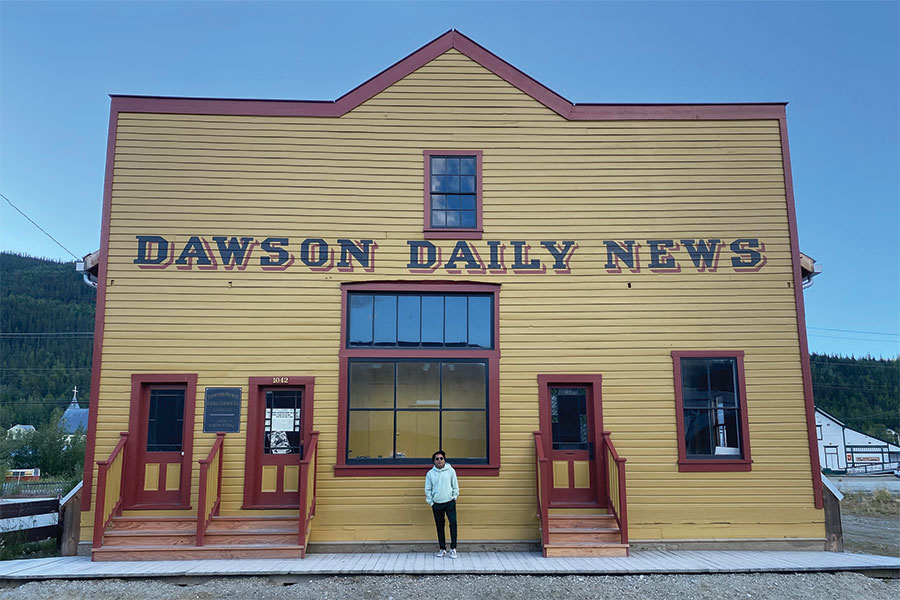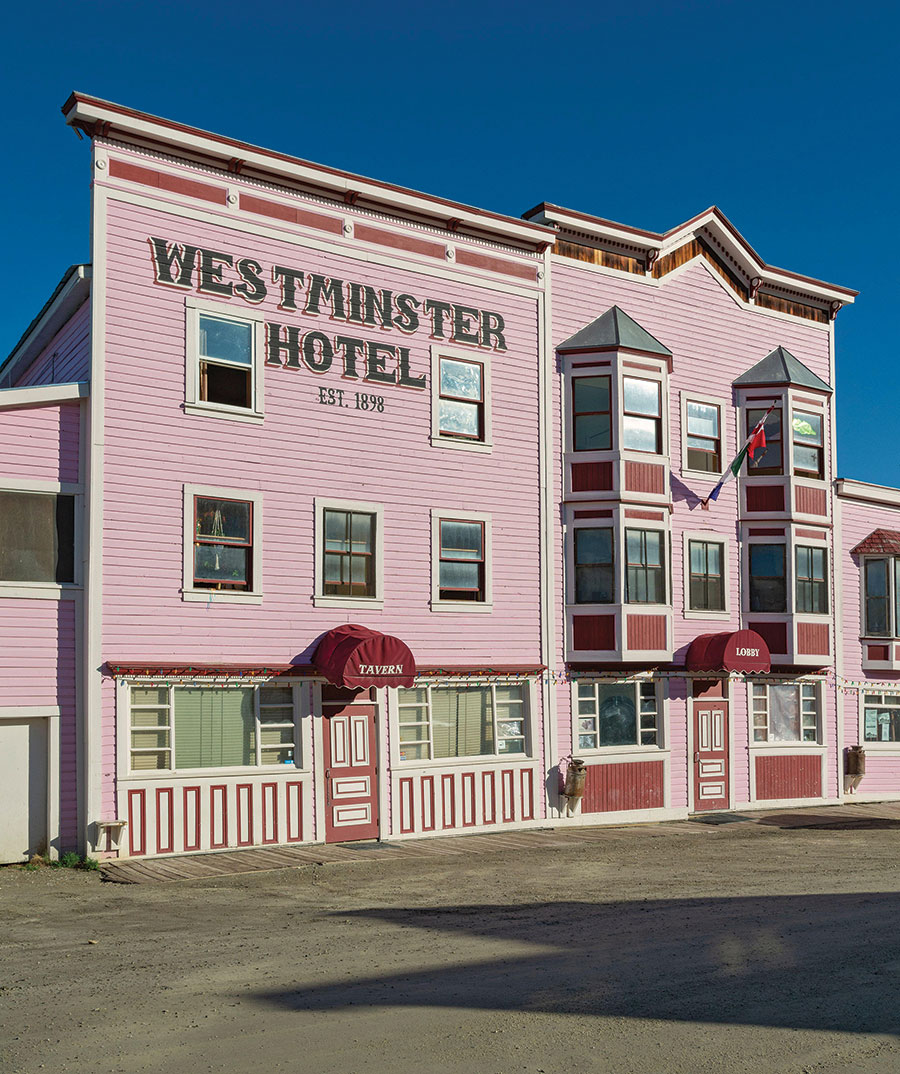Dawson City: Where the Wild Things Were

Dawson City is nestled in a bend of the Yukon, one of North America’s longest rivers. During the Gold Rush it teemed with paddle boats. Photo: Edgar Bullon/Alamy Stock Photo
Dawson City’s faded grandeur, mesmerizing setting and burgeoning art scene surprises Shinan Govani, who finds it’s very much his cup of tea.
As I walked the circumference of Dawson City, Yukon — the quintessential Gold Rush boom town — I found myself drinking in its quirks and its peaks. I had never really considered going so far north, but on this brilliant August morning, immersed in a sound bath of birdsong, I drank it in. Above me: a sky so big it could be its own continent. In front: an opening in the trees giving way to a vista of the Yukon, the third longest river in North America. It looked so still and so vast – the word transcendent might be useful to dislodge here – that it seemed impossible when told by a guide whose family is generations deep here, that in a few months it would be entirely frozen over.
In this place, where everything moves to the intractable whims of the elements, the choreography of the seasons begins as soon as the first heavy snow falls (typically in mid-September). At that point, the highway into town closes, the ferry, too. And for a few weeks, the residents of West Dawson are cut off from town as they wait for the river to fully glaze over. “[The freeze-up] is like our version of the red carpet,” our guide quips. People around here appear to revel in the adventure: Kids are pulled from school, and provisions stocked up. The river transforms once ice pans start floating downstream, then crush together.
Life on the 64th parallel is a place where, during summer (when I was there), the sun rises and sets in the north, and daylight clings on way past midnight, giving it all a sort of eerie, magical wash. And where it became manifestly clear to me that time itself – like the river – also has a way of freezing.

At one point, after all, Dawson City was the most populous city west of Winnipeg and north of Seattle, its population swelling to a high of 30,000 in the two years after gold was first discovered by four prospectors in 1896 in nearby Rabbit Creek. Today, in contrast, it hovers at about 1,400, spiking somewhat in the summer when artsy adventurer types and nouveau hippies from larger metropolitan cities descend on Dawson to make it swing again. Not to mention, drill its nostalgia.
Back in the day, it had so much Gilded Age glamour there was — get this — an opera house in town. With tens of thousands of gold-seekers pouring in and overnight millionaires seeking ways to pass their time and spend their dough during the dark, freezing, winter months, there was no shortage of restaurants, brothels and saloons, vestiges of which remain. There was also a slew of theatres, including the Palace Grand, opened in 1899 by American showman Arizona Charlie Meadows, who liked to dazzle the crowd with his marksmanship — until he shot off the tip of his wife’s finger one night. To give you even more of a sense of the cosmopolitan frisson in these parts, there were four daily newspapers: The banner of the Dawson Daily News still stares out from a storefront, a nod to the city’s own erstwhile “Fleet Street.”

So much money flowed through Dawson City, and it was the funnel of so many fortunes, that this, I learned, is where the Guggenheims added to their riches through their Yukon Gold Company. It’s also where Donald Trump’s grandfather, Fred — born Friedrich Trump in Germany in 1869 — fanned his aspirations by opening a Gold Rush hotel in 1898, “mining the miners,” as Trump biographer Gwenda Blair has described it.
Walking into the old Post Office, its immaculate woodwork still intact — and marked by a three-storey octagonal entrance tower — one is instantly transported to a time when this place would have been the only lifeline for prospectors far, far from their loved ones. To waltz into the Bank of British North America, with its glitzy teller wickets, is to imagine a place where ambition and avarice stalked the streets in the same way ambition and avarice grip make-rich places this century, such as Silicon Valley or even Dubai.
It was mostly men who managed the trek north when the town was first taking shape (only eight per cent of the population was female), which is why it was fascinating for me to learn about Mathilde “Ruby” Scott, an enterprising woman from Paris who managed Ruby’s Place, Dawson’s premier house of prostitution at the time. There is a plaque devoted to it, and to her. Turns out, she became quite the pillar of society as the decades trickled on — and a woman of great influence — from madame to dowager, a classic tale. The expression that Ruby used a lot regarding the city’s male-female ratio (and which apparently originated in these parts) was “The odds are good, but the goods are odd.”
A saying that resonated when I checked out Diamond Tooth Gerties Gambling Hall, which prides itself on being Canada’s oldest casino, and I imagined the swarms of men gambling their hard-earned gold here. During the height of summer, visitors swell the town to about 2,500, and weekends portend a party crowd that takes on the fizz of a minor New Orleans. Gerties is knee-deep in mischief and blackjack: Three live shows happen a night, too — one is a kind of jazzy old-timey number, one a cabaret-style affair and the other a sort of variety show taking on more contemporary music. Which is how I wound up watching a modern dance interpretation of Britney’s “Toxic” in Pierre Berton country (the mighty Canadian writer famously grew up here), while two 30-somethings at a roulette table eagerly informed me they were on a Tinder date. A different sort of rush, perhaps?

Pleasure is still certainly on the menu in Dawson City — this time for travellers instead of fortune hunters — there’s even an award-winning restaurant, BonTon & Company, in this place of about 11 blocks. The newish, nose-to-tail restaurant won a spot in enRoute’s Best New Restaurants in Canada in 2021. Here, rather than finding the expected meat and potatoes, you’ll discover the best fusion tapas you can have some 200 kilometres south of the Arctic Circle, with brawny young men eating slow-roasted pork with kimchi or gado gado salad with shredded Kokopellie cabbage, under the midnight sun.

Any jaunt to Dawson must also include a stop at The Pit, a proper dive bar inside the Pepto-pink Westminster Hotel. A hangout for hipsters, the place oozes atmosphere with dusty trophy heads mounted on the walls, bawdy turn-of-the-century oil paintings, pressed-tin ceilings and live music. For more libations, drop into the Sourdough Saloon, where the queasy-making rite of passage includes ordering a drink with a preserved toe (don’t ask).
You can still pan for gold here (at Claim 33 Gold Panning and Mining Museum) or visit some of the historic dredges. Or, if you want to absorb this “Marfa of Canada,” as GQ coined it, go to the boho weekend food markets, or drop in on the Klondike Institute of Arts and Culture, where there’s a global rotation of artists in residence, art shows and events. Chances are the hipster serving your drink is part of the thriving art scene in Yukon at large (inspiration-seekers are frequently drawn here by its physical beauty, as well as a chance to live “off the grid,” so to speak).

Tag and share your snaps of our beautiful country at #ImagesOfCanada. Photo: Edgar Bullon/Alamy Stock Photo
To get more context about the place, I also recommend paying a visit to the Commissioner’s Residence, a grand yellow home with white trim that once housed the territory’s head of state, whose job involved wooing investors to the area. Much of it shows the opulence of a faded era — a dinner table is set, for instance, showing the original ultra-posh place settings, including the lemons that would have had to come all the way from southern Florida (how far your food had to travel was a marker of status). The city’s historical society has now pivoted to use this opportunity to talk about the darker side of the Gold Rush, including the legacy of colonialism and how the area’s Indigenous people were manipulated into selling their lands as masses of eager prospectors (30,000 in three years) descended on the region. Something on which I could not help but reflect during my days in Dawson.
The weight of history. The expanse of the terrain. While I was taking a helicopter tour over Tombstone Territorial Park — a splurge that I highly recommend to get a sense of scale and the drama of the landscape — it hit me that, while this wasn’t a place I had felt an urge to see, its faded glory, astonishing setting and lore had made a mark on me. I left thinking: This is one trip I will likely never forget. Strange, and fun, and confounding, and all that glitters.
Travel Notes
Where to Stay:
For old-fashioned, Gold Rush-era atmosphere, try the Westminster Hotel, in operation since the 1930s.

Don’t Miss:
Culture: Visit the Dänojà Zho Cultural Centre to learn about the Tr’ondëk Hwëch’in people, and what happened to their way of life and culture when tens of thousands of stampeders arrived in Dawson City.
Outdoors:
Summer: Hike the Midnight Dome for sweeping views of the Yukon River and valley. On a clear day you can see the Ogilvie Mountain Range in the far distance.
Winter: Book a dog-sledding excursion with local outfitters Wild Country Dog Sled Adventures. You can find them on Facebook.
Water: Experience the mighty Yukon River with Klondike Adventure River Tours, specialists in raft and canoe trips (and rentals).
Shop: The gift shop at the Dänojà Zho Cultural Centre has a beautiful array of crafts from the Yukon and northern First Nation sewers, including intricately beaded moccasins, hand-stitched birch bark boxes and jewelry.
How to get there: Air North flies from the Yukon to destinations in northern and western Canada throughout the year. They offer seasonal service to Toronto and Ottawa.
A version this article appeared in the June/July 2023 issue with the headline ‘Where the Wild Things Were’, p. 84.
RELATED:
Canadian Staycation: Must-See Stops and Stays in Yukon
From the Rockies to Red Rocks: Taking the Train From Colorado to Utah